Physical Address
304 North Cardinal St.
Dorchester Center, MA 02124
Posterior tarsal tunnel syndrome is caused by compression of the posterior tibial nerve as it passes through the posterior tarsal tunnel. The posterior tarsal tunnel is made up of the flexor retinaculum, the bones of the ankle, and the lacunate ligament. In addition to the posterior tibial nerve, the tunnel contains the posterior tibial artery and a number of tendons, which are subject to tenosynovitis ( Figs. 183.1 and 183.2 ). The most common cause of compression of the posterior tibial nerve at this anatomic location is trauma to the ankle, including fracture, dislocation, and crush injuries. Thrombophlebitis and aneurysms involving the posterior tibial artery also have been implicated in the evolution of posterior tarsal tunnel syndrome ( Fig. 183.3 ). Patients with rheumatoid arthritis have a higher incidence of posterior tarsal tunnel syndrome than the general population. Posterior tarsal tunnel syndrome is much more common than anterior tarsal tunnel syndrome.



Posterior tarsal tunnel syndrome manifests in a manner analogous to carpal tunnel syndrome. The patient reports pain, numbness, and paresthesias of the sole of the foot. These symptoms also may radiate proximal to the entrapment into the medial ankle. The medial and lateral plantar divisions of the posterior tibial nerve provide motor innervation to the intrinsic muscles of the foot. The patient may note weakness of the toe flexors and instability of the foot caused by weakness of the lumbrical muscles. Nighttime foot pain analogous to the nocturnal pain of carpal tunnel syndrome often is present.
Physical findings include tenderness over the posterior tibial nerve at the medial malleolus. A positive Tinel sign just below and behind the medial malleolus over the posterior tibial nerve usually is present. Active inversion of the ankle often reproduces the symptoms of the posterior tarsal tunnel syndrome. Weakness of the flexor digitorum brevis and the lumbrical muscles may be present if the medial and lateral branches of the posterior tibial nerve are affected.
Posterior tarsal tunnel syndrome often is misdiagnosed as arthritis of the ankle joint, lumbar radiculopathy, or diabetic polyneuropathy. Patients with arthritis of the ankle joint have radiographic evidence of arthritis. Most patients with a lumbar radiculopathy have reflex, motor, and sensory changes associated with back pain, whereas patients with posterior tarsal tunnel syndrome have no reflex changes and have motor and sensory changes limited to the distal posterior tibial nerve. Diabetic polyneuropathy generally manifests as symmetric sensory deficit involving the entire foot, rather than limited just to the distribution of the posterior tibial nerve. Lumbar radiculopathy and posterior tibial nerve entrapment may coexist as the so-called double crush syndrome. Furthermore, because posterior tarsal tunnel syndrome is seen in patients with diabetes, it is not surprising that diabetic polyneuropathy usually is present in diabetic patients with posterior tarsal tunnel syndrome.
Electromyography helps distinguish lumbar radiculopathy and diabetic polyneuropathy from posterior tarsal tunnel syndrome. Plain radiographs are indicated for all patients with posterior tarsal tunnel syndrome to rule out occult bony disease. On the basis of the patient’s clinical presentation, additional testing may be indicated, including complete blood count, uric acid, sedimentation rate, and antinuclear antibody testing. Magnetic resonance imaging (MRI) and/or ultrasound imaging of the ankle and foot is indicated if joint instability or a space-occupying lesion is suspected ( Figs. 183.4 and 183.5 ). The injection technique described later serves as both a diagnostic and a therapeutic maneuver.


The tibial nerve is 1 of the 2 major continuations of the sciatic nerve, and the other is the common peroneal nerve. The tibial nerve provides sensory innervation to the posterior portion of the calf, the heel, and the medial plantar surface. The tibial nerve splits from the sciatic nerve at the superior margin of the popliteal fossa and descends in a slightly medial course through the popliteal fossa. The tibial nerve at the ankle lies just beneath the popliteal fascia and is readily accessible for neural blockade. The tibial nerve continues its downward course, running between the 2 heads of the gastrocnemius muscle, passing deep to the soleus muscle. The nerve courses medially between the Achilles tendon and the medial malleolus, where it divides into the medial and lateral plantar nerves, providing sensory innervation to the heel and medial plantar surface (see Figs. 183.1 and 183.2 ). The tibial nerve is subject to compression at this point as the nerve passes through the posterior tarsal tunnel. The posterior tarsal tunnel is made up of the flexor retinaculum, the bones of the ankle, and the lacunate ligament. In addition to the posterior tibial nerve, the tunnel contains the posterior tibial artery and a number of flexor tendons.
Become a Clinical Tree membership for Full access and enjoy Unlimited articles
If you are a member. Log in here